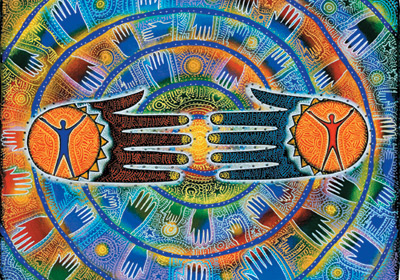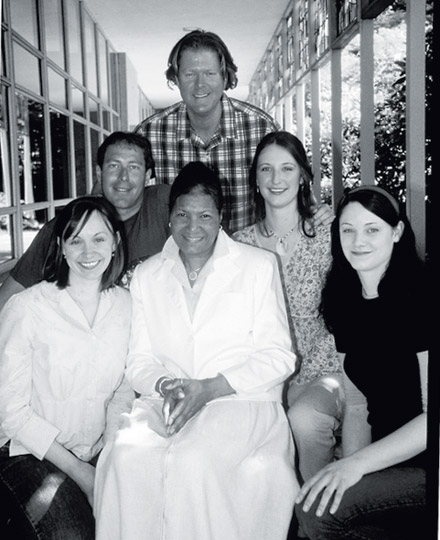Forging Partnerships, Healing Lives
Open gallery

by Romel Hernandez
A 10-year-old boy ripped apart by a family that includes a mother and stepfather who are addicted to methamphetamine. He keeps his emotions bottled up so tightly that at first he can express his deepest feelings only by attacking a foam football, throwing, kicking, and stamping it to venthis anger and pain.
A homeless mother grappling with drugs and disabilities. She adores her three children, all of whom are living with foster families, but she is unable to take care of them. She finally realizes that the most loving thing she can do for her kids is to let them go, tearfully putting them up for open adoption.
A middle-aged man struggles with depression, masking his pent-up loneliness behind a friendly smile. He slowly learns to confront his problems and find meaning and hope in his relationships. He builds a “depression survival kit” filled with poignant reminders of the people and things he loves.
These are some of the people getting the help they need at various Portland-area social service agencies from Lewis & Clark graduate students training in the new Marriage and Family Therapy Program. The community partnership benefits both sides. The students gain invaluable work experience as part of their education. Their low-income clients receive free counseling that helps them change their lives. And as a college and a community reach out to one another, a new connection grows.
Lewis & Clark’s Graduate School of Education recently added “and Counseling” to its official name—a change intended to better reflect the school’s diverse offerings, but which also underscores how much the counseling psychology program has grown and developed. This year marks another milestone for the program as the first Marriage and Family Therapy students receive their master’s degrees.
Over the summer, students are wrapping up the therapy internships that form the crux of their third and final year. They are out working in the community, serving as volunteer therapists with an array of social service organizations. The students’ caseloads include children and adults, couples and whole families, all of them facing issues running from clinical depression to anger management to substance abuse.
“You need to learn to create solutions with families in their own environment,” says Barbra Fletcher Stephens, assistant professor of counseling psychology and coordinator of the marriage and family therapy program. “You have to be where the problems start, so you can help find the solutions in the right context.”
The driving force behind the Marriage and Family Therapy Program is unquestionably Fletcher Stephens, who designed and launched the program in 2002 after graduate students expressed interest in such a specialization.
She’s a bundle of energy,” says Tod Sloan, professor of counseling psychology and department chair. “She is totally committed to the success of this program.”
Fletcher Stephens is an East Coaster who split her early years between Philadelphia and rural Virginia. Spending summers at the family farm, she grew especially close to her maternal grandparents, both of Accohannock Indian heritage. From her family, she says, she gained a profound appreciation for integrity and hard work that continues to guide her work today.
“I have always remembered where I came from,” she says. “I have always known who I am.”

Fletcher Stephens earned degrees from Wilberforce University (a historically black school in Ohio), Kent State University, the University of Akron, and the Union Institute and University. She went to work with developmentally disabled and troubled youths. At first she took some hard knocks— literally. She recalls getting attacked by an emotionally disturbed teenager, who knocked her out and stuffed her into a trash can. When she later joined the counseling staff of a battered-women’s shelter, her desk was an old door propped across two chairs.
She was directing the Family Therapy Institute in Canton, Ohio, in partnership with the University of Akron and Case Western Reserve, Kent State, and Walsh universities, when an ad in the Chronicle of Higher Education caught her eye. A small liberal arts college in Oregon was looking to launch a marriage and family therapy program.
Everyone is connected.
From the first day of class, Fletcher Stephens drills into her students the importance of seeing people as part of “systems”— the complex webs of relationships tying them to family, friends, and society.
In contrast to traditional psychoanalysis, which tends to view people as “patients” and digs deep into psyches for submerged traumas, marriage and family therapy focuses on clients in a social context. Rather than passing judgment or prescribing answers, the therapist acts as a coach and collaborator, guiding clients to draw their own conclusions and set their own life goals. Instead of dwelling on the problems of the past, the therapist concentrates on the future and steers clients toward pragmatic solutions.
A client often enters therapy obsessing about everything that’s wrong. A skilled marriage and family therapist will listen and validate those experiences, then shift the focus to future possibilities and what’s going right. A simple solution to a client’s troubles may seem readily apparent within the first five minutes of the first therapy session, Fletcher Stephens tells her students. But if change is truly going to take hold and last, therapists need to give clients the time to seek and find their own answers to their problems.
Ultimately, it’s not about providing answers. It’s about asking the right questions. “They have all these people telling them what to do to fix their lives,” says Rachel Heron, a third-year student. “What we do is help them see they have the strength within themselves to make changes.”
During a recent class, one student admitted he was getting impatient with a client’s seeming unwillingness to make progress in therapy. Fletcher Stephens’ rapport with students usually involves asking lots of open-ended questions, but this time she was far more direct, cutting right to the point.
“You’re not going to see results right away,” she said, peering intently over her glasses. “Your manner needs to be very soft. You must measure your words carefully. You must be patient.”
Fletcher Stephens’ students describe her as direct and demanding, and several admit they found her intimidating at first. She can be brutally blunt, but a word of praise from her is like a shiny medal. She can also be quite formal; students had to sell the merits of addressing her as “Barbra” rather than “Dr. Fletcher Stephens.” At the same time, she is a nurturer. She takes time to know her students, and cares about their personal, as well as their professional, growth.
She makes no excuses for her tough-love approach.
“I view myself as a gatekeeper to the profession,” she says. “If my students can rise to the highest standard every time they are challenged, then they will have earned the right to be gatekeepers too.”
The Marriage and Family Therapy Program’s first graduating class is small, with just six students. They range in age from their early 20s to late 30s and hail from all over the country. They have different motivations, but they share a common passion to help.
Dana Riemer, for example, lived in foster care after his mother died, and now wants to work with children going through their own hard times. Marisa Macho was a quiet child who expressed herself through ballet. She now wants to help others find their unique voices. Tom Kelley used to sell sports cars for a living. He measured success by the expensive toys and exotic vacations he could buy.
“Now,” Kelley says, “success comes from seeing people smiling for the first time in a long time.”
The experience of being the first students through the program caused them to form a tight bond. They encountered bumps, but the challenges were outweighed by the rewards of helping shape the program.
Students in the Marriage and Family Therapy Program spend their first two years in the classroom, getting a solid grounding in philosophy and technique. At the start of the third year, theory turns into reality.
That’s when they are thrust into the real world, working directly with real clients dealing with real problems. The students are all tightly supervised, meeting weekly with faculty supervisors. They also videotape therapy sessions and replay them to the class for critiques, getting feedback from their peers. The program is developing a research component so students can incorporate clinical data into research about best practices and outcomes.
The experience of meeting clients face- to-face for the first time can be intimidating.
“We do a lot of role-playing to get the feeling of it, but nothing can really prepare you for that,” says Kenny Wolford, a third-year student. “You have to remember there’s nothing wrong with a bit of silence in a session. At first you want to talk to fill the gaps, but then you learn to wait and let the client fill the space.”
By the time the students complete their requirements, each will have logged a whopping 500 client contact hours. That’s more than many other graduate programs, but the number is in keeping with the standards set out by the national Commission on Accreditation of Marriage and Family Therapy Education.
Most college counseling programs establish on-campus clinics where clients come to seek services. But the Marriage and Family Therapy Program has embraced the idea that to truly connect with a community, students must come down from Palatine Hill. So the students are out volunteering as therapy interns with nonprofit agencies across the Portland area, including Southeast Works, a jobs center for the chronically unemployed, and Self-Enhancement Inc., an academic and social organization for African-American youths and families.
The College’s Marriage and Family Therapy Program has forged a key partner- ship with Portland Impact, an agency that offers a wide range of social services to low- income families and individuals. While the organization employs social workers who assist clients by connecting them with housing, employment, and other social services, it has long wanted a full-fledged counseling program to deal with root causes of social problems.
“This really was a missing piece for our families,” says Suzanne Washington, deputy director of Portland Impact. “From our standpoint, it’s a fantastic partnership. The students are wonderful.”
In fact, Portland Impact expects to open a brand-new community center by next summer and is already making plans to include clinical and research space for future Lewis & Clark graduate students.
Fletcher Stephens hopes to see the Marriage and Family Therapy Program continue to flourish and gain prestige. Already, next year’s entering class will be twice the size of this year’s, bringing the total number of students in all phases of the program to 40. Her priority is to build a program with integrity, rooted in the College’s off-campus connections. She wants the program to become a living, thriving system within the community.
Tacked to Fletcher Stephens’ office door is a quotation that reminds her of her own family heritage and of the importance of respecting the invisible ties that bind everything together in the world. The quotation comes from Chief Rudy Hall, an Accohannock tribal leader: “Everything is connected. Every star in the sky, every blade of grass in the field, has a greater purpose. And that purpose is inextricably intertwined with the life and destiny of every living human.”
Romel Hernandez is a freelance writer in Portland.
More L&C Magazine Stories
Lewis & Clark Magazine is located in McAfee on the Undergraduate Campus.
MSC: 19
email magazine@lclark.edu
voice 503-768-7970
fax 503-768-7969
The L&C Magazine staff welcomes letters and emails from readers about topics covered in the magazine. Correspondence must include your name and location and may be edited.
Lewis & Clark Magazine
Lewis & Clark
615 S. Palatine Hill Road MSC 19
Portland OR 97219

